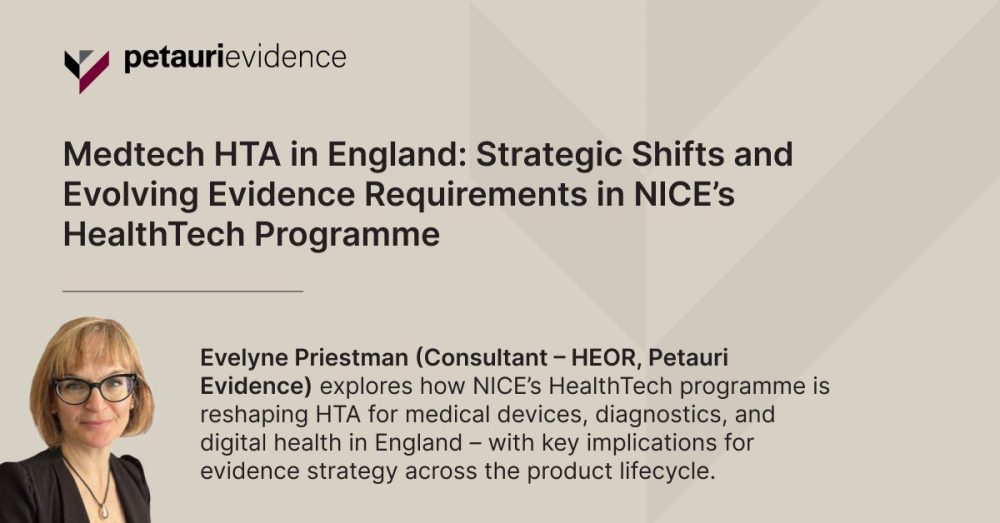Medtech HTA in England: Strategic Shifts and Evolving Evidence Requirements in NICE’s HealthTech Programme

Evelyne Priestman (Consultant – HEOR, Petauri Evidence) explores how the National Institute for Health and Care Excellence (NICE)’s evolving HealthTech programme is reshaping the health technology assessment (HTA) landscape for medical devices, diagnostics, and healthtech in England, with implications for evidence strategy across the product lifecycle.
In a quiet but consequential overhaul, NICE is retiring its legacy Medical Technologies Evaluation Programme (MTEP), Interventional Procedures Programme (IPP), and Diagnostics Assessment Programme (DAP) in favour of a consolidated HealthTech programme. The new model, more aligned with product lifecycles than with technological taxonomy, introduces a tripartite structure: early use, routine use, and existing use. Product categorisation, determined jointly by NICE and the Department of Health and Social Care (DHSC), sets the stage for how a technology will be assessed.
Gone is the era of bespoke company submissions. Under the new regime, manufacturers respond to NICE’s requests for information, ideally with complete evidence dossiers and fully executable health economic models. Evaluations are conducted by external assessment groups (EAGs) and, while single technology appraisals remain possible, the emphasis is now on multi-tech evaluations.
Early Use Assessment: A Welcome Door for Innovation
The early use assessment pathway (formerly called the Ealy Value Assessment) is perhaps the most reformist element of the programme. It offers a pragmatic route into the National Health Service (NHS) for digital tools, diagnostics, and devices still in the early stages of evidence generation. For innovators long stymied by the cost and complexity of traditional NICE submissions, this route into the NHS is a lifeline. It acknowledges that not every promising technology arrives with a portfolio of randomised controlled trials (RCTs).
The process, adapted from the DAP model, includes topic selection, scoping, EAG review, and conditional recommendations. Crucially, NICE may provide an evidence generation plan, giving companies a period of up to 3 years or more to plug gaps before re-evaluation. If uncertainties remain unresolved, approval may be withdrawn.
Routine Use: Multi-Tech Appraisals and the Return of Cost Effectiveness
Technologies deemed ready for routine use face a more rigorous comparative process. NICE and DHSC select categories, and evaluations focus on relative cost effectiveness, echoing the pharmaceutical appraisal model. Though specific NICE guidance for this route is yet to be published, we anticipate that price negotiations and discounting are back on the table, with the NICE threshold looming large. For suppliers, this marks a shift from selling features to defending value.
Existing Use Assessment and the Price of Incrementalism
The existing use assessment pathway (formerly called late-stage assessment) targets technologies already embedded in NHS procurement. Here, NICE is less interested in novelty and more concerned with value for money. Categories include high cost/low volume as well as low cost/high volume items. The assessment will centre around technologies within a specified category and will be multi-tech appraisals focused on evaluating the evidence underpinning the value of incremental innovation in this space. A new emphasis on user preference marks a notable shift: by capturing experience and usability beyond clinical or economic metrics, NICE is recognising subtler forms of innovation in mature technologies.
For existing use products, NICE’s stance appears softer. Only in exceptional cases will it issue a “should not be used” ruling. More often, guidance will endorse use outright or outline the factors clinicians should consider when choosing between alternatives. In effect, NICE is signalling a more pragmatic approach: less about exclusion, more about informed choice.
Looking Ahead: Strategic Uncertainty and the Need for Evidence Readiness
The early use pathway is a clear win for early-stage innovators. But for suppliers of routine and existing technologies, the new multi-tech evaluations pose strategic challenges. The risk is that incremental innovation, once a safe bet, may now be penalised unless backed by compelling evidence.
NICE has outlined its early priorities for 2025–2026, indicating that initial product categories selected for assessment under the HealthTech programme will come from the following disease areas: mental health, early cancer detection/diagnosis, diabetes, musculoskeletal conditions, women’s health, respiratory, and neurology. Companies with technologies in these spaces should be prepared for early engagement and ensure their evidence strategies are aligned with NICE’s evolving expectations.
How this programme plays out remains uncertain, especially under the financial strain facing the NHS. What is clear is that NICE is signalling a shift: leaner, more comparative, and less forgiving of unsubstantiated claims. For companies, the message is simple –strengthen your evidence base, or risk being left behind.
For medtech companies navigating these changes, early clarity on evidence strategy is essential. Whether you're preparing for early use, routine use, or existing use assessment, our experts can help you interpret NICE’s evolving HTA approach and plan for access with confidence. To explore what these shifts mean for your technology and how to strengthen your evidence base ahead of assessment, email evidence@petauri.com.

Share